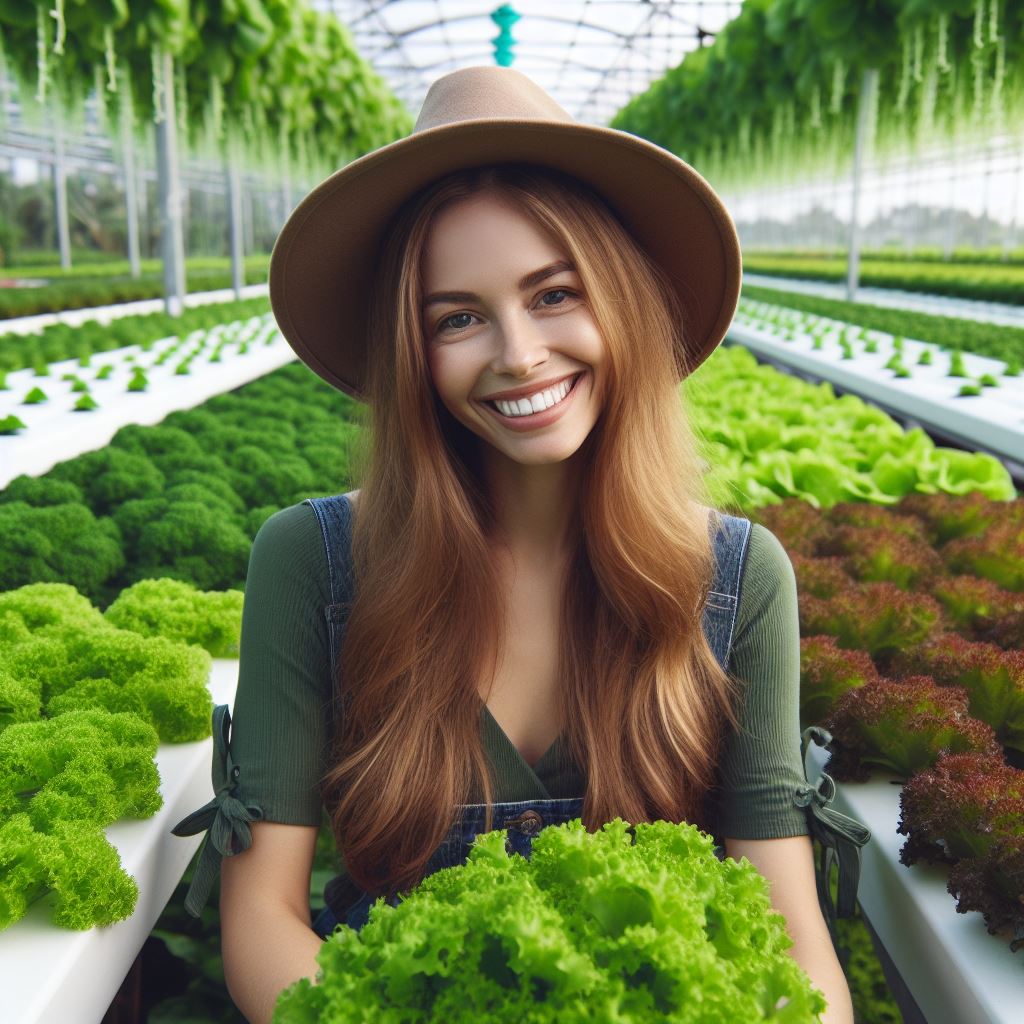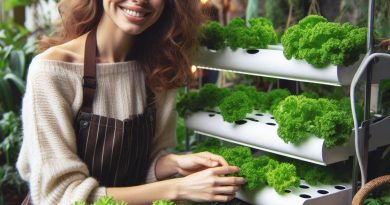Herbs & Greens: Hydroponic Gardening Easy
Last Updated on March 2, 2024
Introduction
Craving fresh herbs and vibrant greens year-round?
Enter hydroponics, a revolutionary approach to growing plants without soil.
Hydroponics nourishes plants with a water-based nutrient solution, allowing for precise control over growth conditions.
This innovative method unlocks a treasure trove of benefits for cultivating herbs and greens.
Imagine faster-growing plants, yielding more lush greenery in less time.
Picture space-saving setups, maximizing your home or professional kitchen’s potential.
Envision minimizing pests and diseases, ensuring healthy, thriving harvests.
Year-round access to fresh, high-quality herbs and greens becomes a reality.
Whether you’re a culinary professional or a home cook, hydroponics offers an exciting path to cultivate a flourishing indoor herb garden.
Dive deeper with us as we unveil the secrets of a successful hydroponic herb garden.
Learn how to set up your system, care for your plants, and enjoy the endless possibilities of hydroponic greens.
Benefits of Hydroponic Gardening
Hydroponic gardening saves water compared to traditional gardening
Hydroponic gardening offers numerous advantages over traditional soil-based gardening methods.
One significant benefit is the ability to save water.
In hydroponic systems, water is efficiently recycled and reused, resulting in reduced water wastage compared to traditional gardening.
This conservation of water resources is crucial in areas facing water scarcity or high water costs.
Hydroponic gardening allows for year-round growth of herbs and greens without soil
Additionally, hydroponic gardening allows for the cultivation of herbs and greens year-round without the need for soil.
In traditional gardening, the planting season is limited by soil quality and weather conditions.
However, by using nutrient-rich water instead of soil, hydroponic systems provide the perfect environment for continuous growth.
This means that fresh herbs and greens can be harvested throughout the year, regardless of the weather outside.
Hydroponic gardening provides control over nutrient levels and pH balance
Another advantage of hydroponic gardening is the control it offers over nutrient levels and pH balance.
In traditional gardening, nutrient availability in the soil can vary, leading to inconsistent plant growth.
In hydroponic systems, nutrient solutions can be precisely measured and adjusted to meet specific plant needs.
This ensures that plants receive optimal nutrition, promoting healthier and more abundant growth.
Furthermore, pH levels in hydroponic systems can be easily monitored and adjusted.
Unlike traditional gardening, where soil pH fluctuations can be challenging to manage, hydroponic gardening allows for precise control.
The ability to maintain the ideal pH balance creates an optimal growing environment and prevents nutrient deficiencies or toxicities that can hinder plant development.
Essentially , hydroponic gardening offers several benefits that make it an attractive option for growing herbs and greens.
Not only does it save water by recycling and reusing, but it also enables year-round cultivation without the limitations of soil quality or weather.
The control over nutrient levels and pH balance ensures healthier plant growth and minimizes the risk of nutrient imbalances.
Whether you have limited garden space or want greater control over your plants’ environment, hydroponic gardening is a practical and efficient solution.
Read: Hydroponics vs. Soil: What’s Best for You?
Getting Started with Hydroponic Gardening
Different types of hydroponic systems available for beginners
When it comes to hydroponic gardening, there are several types of systems that beginners can choose from.
Each system has its own advantages and disadvantages, so it’s important to understand the differences before setting up your own garden.
- Nutrient Film Technique (NFT) System: In this system, a thin film of nutrient-rich water continuously flows over the roots of the plants. This allows them to absorb the necessary nutrients while providing a constant oxygen supply.
- Deep Water Culture (DWC) System: This system involves suspending the plants’ roots in a nutrient-rich solution. An air pump then provides oxygen to the roots, ensuring their healthy growth.
- Drip System: With this system, a timer-controlled pump drips nutrient solution onto the base of each plant. This method is simple and versatile, making it an excellent choice for beginners.
- Aeroponic System: In an aeroponic system, the roots of the plants are exposed to a fine mist of nutrient-rich water. This allows for maximum oxygen absorption and promotes rapid growth.
Necessary equipment and materials to set up a hydroponic garden
To set up a hydroponic garden, you will need a few essential equipment and materials.
These are necessary for the proper functioning of your chosen system and ensuring the healthy growth of your plants.
- Grow Trays: These containers hold the plants and the nutrient solution. They should be watertight and made of a material that won’t react with the nutrient solution.
- Growing Medium: Hydroponic systems require a growing medium to support the plants’ roots. Common options include perlite, coconut coir, and clay pellets.
- Nutrient Solution: This solution contains all the necessary nutrients that plants need for their growth. It should be mixed according to the specific requirements of the herbs and greens you plan to grow.
- pH and EC Meters: These tools are used to measure the acidity (pH) and electrical conductivity (EC) of the nutrient solution. Maintaining the proper pH and EC levels is crucial for optimal plant growth.
- Lights: Since hydroponic gardens are often grown indoors, you’ll need artificial lights to provide the necessary light spectrum for photosynthesis. LED grow lights are a popular choice due to their energy efficiency and long lifespan.
Tips on how to choose the right herbs and greens to grow hydroponically
When selecting herbs and greens for your hydroponic garden, there are a few factors to consider.
The right choices will ensure a successful and bountiful harvest.
- Easy-to-grow Varieties: As a beginner, it’s advisable to start with herbs and greens that are known for their ease of cultivation. Examples include basil, lettuce, spinach, and mint.
- Space and Light Requirements: Different herbs and greens have varying space and light requirements. Consider the available space in your hydroponic garden and the lighting system you have in place before making your selection.
- Duration to Maturity: Some herbs and greens grow more quickly than others, and it’s important to choose varieties that align with your desired time frame. Fast-growing options like arugula and cilantro can offer quicker harvests.
- Taste and Culinary Use: Ultimately, choose herbs and greens that you enjoy eating and can be easily incorporated into your meals. Consider their flavor profiles and how they can enhance different dishes.
Remember that experimentation and learning from experience are key in hydroponic gardening.
Don’t be afraid to try new plants and adjust your techniques along the way.
With time and practice, you’ll become a successful hydroponic gardener, enjoying the fresh herbs and greens you grow right at home.
Read: Fish-Powered Gardens: Aquaponics Guide
Setting Up a Hydroponic Garden
Importance of a Suitable Location with Access to Light and Electricity
Selecting the right location for your hydroponic garden is crucial for the success of your herbs and greens.
Here’s why:
- Adequate Light Supply: Choose a spot where your plants can receive at least 8-12 hours of direct sunlight or artificial grow lights. Light is essential for photosynthesis, ensuring healthy growth and abundant yields.
- Easy Access to Electricity: Hydroponic systems require electrical components such as pumps, timers, and lights. Having a nearby power source makes it convenient to operate and maintain your setup.
Different Growing Mediums for Hydroponics
Hydroponics offers various growing mediums that provide stability and support to your plants’ roots.
Consider these options:
- Rockwool: Made from rocks or minerals, this synthetic medium retains moisture and promotes consistent water and nutrient distribution to the plants.
- Coconut Coir: Derived from coconut husks, coir is a sustainable and lightweight medium that retains water while allowing proper air circulation.
- Expanded Clay Pebbles: These inert clay balls provide excellent drainage, are reusable, and prevent the accumulation of excess water around the plant roots.
- Perlite: Made from volcanic glass, perlite is lightweight and porous, promoting good airflow and drainage while still retaining adequate moisture.
Steps involved in Setting Up a Hydroponic System for Herbs and Greens
Follow these steps to establish a successful hydroponic garden for cultivating herbs and greens:
- Design and Plan: Determine the size and layout of your hydroponic system, considering factors like space availability and the number of plants you wish to grow.
- Gather Equipment: Acquire the necessary materials such as grow lights, reservoirs, pumps, timers, trays, and a pH testing kit for monitoring nutrient levels.
- Install Lighting: Set up your grow lights according to the specifications recommended for the specific plants you intend to grow. Ensure proper distance and light spectrum for optimal growth.
- Assemble the System: Follow manufacturer instructions to build your hydroponic system, connecting all components securely. Double-check for leaks or loose connections.
- Mix Nutrient Solution: Prepare a suitable nutrient solution using a hydroponic-specific fertilizer and follow the manufacturer’s instructions for accurate dilution ratios.
- Transplant Seedlings: Once your system is ready, carefully transfer your seedlings into the chosen growing medium, ensuring their roots are securely placed.
Additional steps
- Monitor and Adjust: Regularly monitor pH levels, nutrient concentrations, and water temperature to maintain a stable and optimal environment for your plants. Make necessary adjustments as needed.
- Water and Feed: Set up a regular watering and feeding schedule, ensuring the roots receive a constant supply of nutrient-rich water while avoiding water stagnation.
- Maintain Growing Conditions: Keep an eye on temperature and humidity levels, ensuring they remain within the appropriate range for the specific herbs and greens you are growing.
- Prune and Harvest: Regularly inspect your plants for any signs of pests or diseases. Prune and harvest your herbs and greens when they reach the desired size, promoting continuous growth.
By choosing a suitable location, understanding the different growing mediums, and following the steps involved in setting up a hydroponic system, you can enjoy a bountiful harvest of fresh herbs and greens throughout the year. Happy gardening!
Read: Indoor Eden: Hydroponic Systems for Home
Nutrient Management in Hydroponic Gardening
Importance of Providing the Right Nutrients for Healthy Plant Growth
In hydroponic gardening, providing the right nutrients is crucial for the healthy growth of plants.
By supplying the essential elements directly to the roots, hydroponics allows for optimized nutrient absorption.
Unlike traditional soil-based gardening, where plants extract nutrients from the soil, hydroponics relies on a nutrient solution.
This solution needs to be carefully controlled to provide the perfect balance of essential nutrients for plants to thrive.
By maintaining proper nutrient levels, hydroponic gardeners ensure that plants receive all the necessary elements for vigorous growth.
The availability of nutrients directly affects plant metabolism, photosynthesis, and overall health.
With the correct balance of nutrients, hydroponically grown herbs and greens can reach their full potential, producing higher yields and superior quality.
Different Types of Nutrients Needed for Herbs and Greens in Hydroponics
Herbs and greens grown in hydroponic systems require a well-rounded nutrient solution that includes macronutrients and micronutrients.
Macronutrients are essential elements required in large quantities, such as nitrogen (N), phosphorus (P), and potassium (K).
Nitrogen promotes lush green growth, phosphorus stimulates root development, and potassium enhances overall plant vigor.
In addition to macronutrients, micronutrients are equally important for plant health.
Micronutrients, including iron, manganese, zinc, and copper, are needed in smaller quantities but are critical for enzyme reactions and nutrient uptake.
Each nutrient plays a unique role in supporting plant growth and development, so it is important to provide a comprehensive nutrient solution.
Guidance on How to Monitor and Adjust Nutrient Levels in a Hydroponic System
Monitoring and adjusting nutrient levels in a hydroponic system ensures that plants receive a consistent supply of nutrients.
Regular testing of the nutrient solution is necessary to identify any deficiencies or imbalances.
Electrical conductivity (EC) and pH are two critical measurements that indicate nutrient availability and solution acidity, respectively.
By using a digital EC meter, gardeners can measure the nutrient concentration in the solution and adjust it accordingly.
Maintaining the appropriate pH range, typically between 5.5 and 6.5, is crucial for optimal nutrient uptake.
pH levels can be adjusted using pH up or pH down solutions.
Any adjustments to nutrient levels should be made gradually to avoid shocking the plants.
Proper record-keeping is also recommended to track any changes made and their effects on plant growth.
By consistently monitoring and adjusting nutrient levels, hydroponic gardeners can ensure healthy and productive plant growth.
In essence, nutrient management is a crucial aspect of successful hydroponic gardening.
Providing the right nutrients in a well-balanced solution is essential for healthy plant growth.
A range of macronutrients and micronutrients is required to support herbs and greens in hydroponics.
Regular monitoring and adjustment of nutrient levels, as well as pH, are necessary for optimal plant development.
With proper nutrient management, hydroponic gardeners can enjoy bountiful harvests of nutrient-rich herbs and greens.
Read: Eco-Friendly Farming: Aquaponics Insights

Delve into the Subject: Tiny Space, Huge Taste: Easy-to-Grow Herbs
Maintaining a Hydroponic Garden
The Importance of Consistent Monitoring and Maintenance in Hydroponics
- Regular monitoring and maintenance are crucial for the success of a hydroponic garden.
- Monitoring nutrient levels, pH, and water temperature ensures optimal plant growth.
- Consistent maintenance prevents nutrient imbalances, root rot, and other problems.
Common Challenges and Troubleshoot Problems in Hydroponic Gardening
- Nutrient deficiency or excess is a common challenge in hydroponics.
- Adjust nutrient solutions accordingly based on plant needs and symptoms observed.
- Root zone temperature fluctuations can be solved by insulating the reservoir and using a water chiller or heater.
- Algae growth can be controlled by keeping the growing area clean and minimizing light exposure to the nutrient solution.
- pH fluctuations can be corrected using pH adjusting solutions or by adding acids or bases to the nutrient solution.
- Clogged or blocked nutrient delivery systems can be fixed by regular cleaning and flushing with clean water.
Tips to Prevent Pests and Diseases in a Hydroponic Setup
- Implement proper hygiene practices by sanitizing tools and equipment regularly.
- Use sterile growing media and regularly inspect for signs of pests or diseases.
- Introduce beneficial insects like ladybugs or lacewings to control pests naturally.
- In case of diseases, quarantine affected plants and treat with appropriate organic fungicides.
- Ensure good air circulation in the growing area to prevent the development of mold or fungal diseases.
- Maintain a strict schedule for monitoring and scouting to catch and address issues promptly.
Maintaining a hydroponic garden requires consistent monitoring and maintenance to ensure optimal plant growth.
Common challenges like nutrient imbalances, temperature fluctuations, and pests can be overcome with proper troubleshooting techniques.
By implementing preventive measures and following good cultivation practices, you can create a productive and disease-free hydroponic setup.
Harvesting and Enjoying Homegrown Herbs and Greens
The best time to harvest herbs and greens in a hydroponic garden
- Harvest herbs and greens when they have reached their peak growth and maturity.
- Look for vibrant color, strong aroma, and healthy leaves as indicators of readiness.
- Avoid harvesting during the hottest part of the day to prevent wilting.
- Regularly monitor plants and harvest when they are at their freshest for optimal flavor.
Tips on how to store and preserve harvested herbs and greens.
- After harvesting, gently wash herbs and greens to remove any dirt or debris.
- Pat them dry or use a salad spinner to ensure they are moisture-free.
- Wrap herbs and greens in paper towels or place them in airtight containers.
- Store in the refrigerator’s crisper drawer to maintain freshness and prolong shelf life.
- Some herbs like basil can be stored in glasses with water on the countertop to mimic freshness.
Various delicious recipes and ways to incorporate homegrown herbs and greens in meals
- Herbs such as basil, parsley, and cilantro can be used as flavor enhancers in sauces and dressings.
- Create vibrant salads by combining lettuce, spinach, arugula, and other leafy greens from your garden.
- Make pesto using fresh basil leaves, pine nuts, garlic, Parmesan cheese, and olive oil.
- Whip up a nutritious green smoothie by blending kale or spinach with fruits like bananas and berries.
- Add chopped herbs and greens to omelettes, scrambled eggs, or frittatas for added color and flavor.
- Infuse oils or vinegars with herbs like rosemary, thyme, or dill to elevate your cooking.
- Use fresh herbs and greens to garnish dishes, enhancing presentation and taste.
- Herb-infused butter or cream cheese can be spread on bread or bagels for a burst of flavor.
- Experiment with herbs and greens in pasta dishes, stir-fries, soups, and stews for a garden-fresh twist.
- Create refreshing herb-infused beverages, such as mint lemonade or basil-infused water, for a unique taste.
In a nutshell, harvesting herbs and greens from your hydroponic garden is an exciting and rewarding experience.
By picking them at the right time, storing them properly, and incorporating them into various recipes, you can enjoy the full benefits of your homegrown produce.
So, roll up your sleeves, grab your shears, and start harvesting the flavors of your hydroponic garden today!
Conclusion
Hydroponics empowers anyone to cultivate a thriving herb garden, regardless of experience.
Imagine harvesting fresh, flavorful herbs and vibrant greens year-round, all from the comfort of your home.
Forget limitations of space or season.
Hydroponic systems maximize yield while minimizing footprint, making them ideal for small kitchens or urban dwellings.
Plus, they eliminate the challenges of soil-borne pests and diseases, ensuring healthy, bountiful harvests.
Embark on this rewarding journey! We’ve equipped you with the knowledge to set up and maintain your own hydroponic herb garden.
Take a leap of faith, embrace the innovative world of hydroponics, and experience the joy of cultivating fresh herbs at your fingertips.


